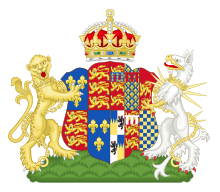Wives of Henry VIII
Annulments declare that a true marriage never took place, unlike a divorce, in which a married couple end their union.Catherine of Aragon, Anne Boleyn, and Jane Seymour each gave Henry VIII one child who survived infancy: two daughters and one son, respectively.By the late 1520s, it was clear Catherine (now in her mid-40s) would not bear any more children, and Henry, increasingly desperate for a legitimate son, planned to marry Anne.Henry, at the time a Roman Catholic, sought the Pope's approval for an annulment on the grounds that Catherine had first been his brother's wife.Anne resisted the king's attempts of letters to seduce her and refused to become his mistress as her sister Mary Boleyn had been.He wrote a love letter that provides evidence of some level of intimacy between them, in which he admires her "pretty duckies" (breasts).[20] It eventually became clear that Pope Clement VII was unlikely to give the king an annulment, so Henry began to break the power of the Catholic Church in England for the current obsession he had with Anne Boleyn.Henry dismissed Cardinal Wolsey from public office and later had the Boleyn family's chaplain Thomas Cranmer appointed Archbishop of Canterbury.[21] Anne was crowned Queen consort of England on 1 June 1533, and she gave birth to Henry's second daughter Elizabeth on 7 September.Despite unconvincing evidence, she was found guilty of engaging in sexual relations with her brother, George Boleyn, and other men, and Anne was beheaded on 19 May 1536 for adultery, incest, and high treason after Henry had his marriage to her annulled just two days before.After the accession of her daughter, Elizabeth I, in 1558, Anne was venerated as a martyr and heroine of the English Reformation, particularly due to the works of John Foxe.[22] Jane, the daughter of Sir John Seymour, a knight, and Margery Wentworth, was probably born at Wulfhall, Wiltshire,[23] although West Bower Manor in Somerset has also been suggested.[24] She was of lower birth than most of Henry's wives, only being able to read and write a little, but was much better at needlework and household management, which were considered much more necessary for women at the time.Almost a year and a half after marriage, Jane gave birth to a male heir, Edward, but then died twelve days later from postpartum complications.It is unclear if this decision was purely sentimental or a political signal designed to reinforce the legitimacy of his youthful heir, Edward, or both of those.Anne did not resist the annulment, claiming the marriage had not been consummated, and was rewarded with a generous settlement including Hever Castle, the former home of the Boleyns.She was given the title of "The King's Beloved Sister" and was a lifelong friend to him and his children; Anne of Cleves was approximately the same age as Henry VIII's eldest surviving daughter Mary.[29] Catherine was stripped of her title as Queen in November 1541 and was beheaded in February 1542 on the grounds of treason for committing adultery.However, when Henry died in 1547, Edward Seymour, 1st Duke of Somerset effectively took up the position, being appointed Protector by the Regency Council.Catherine's badges were a commemoration of the conquest of Granada from the Moors, when the superiority of the Spanish archers gained a victory.Supporters:[40] Badge:[41] An alternative set of supporters for Queen Jane was reportedly: "Dexter a unicorn argent, crowned and unguled or, collared with a double wreath of white daisies and red roses; Sinister, a panther incensed, striped with various colours, gorged with a coronet of crosses patée and fleurs de lys alternately and chained or."[43] The badge of the phoenix rising from the flames was granted posthumously by her son King Edward VI to his maternal relations (who became the Dukes of Somerset), who continue to use it as a crest in their coat of arms to this day.The House of Parr had assumed as a badge "a maiden's head, couped below the breasts, vested in ermine and gold, her hair of the last, and her temples encircled with red and white roses".Season 1, episode 2[53] of the BBC One TV series Horrible Histories included a "Divorced, Beheaded and Died" song[54] and talk-show-style comedy skit starring Henry VIII.[53][55] The Showtime series The Tudors (2007–2010) draws most of its drama from Henry VIII's pattern of idealizing, devaluing, and discarding wives.

















Catherine of AragonAnne BoleynJane SeymourAnne of ClevesCatherine HowardCatherine ParrQueens consortHenry VIII of Englandde jureChurch of EnglandAnnulmentsHenry took several mistressesPrince EdwardQueen Mary IQueen Elizabeth ITower of LondonKing Edward VIThomas SeymourHouse of TudorDavid Starkeymnemonic deviceAnnulmentDeclaration of nullityDivorceepigramAnglophoneretconArthurconsummationBessie BlountHenry FitzRoyfirst cousinslady-in-waitingsweating sicknesspapal dispensationHenry VIIHenry, Duke of Cornwallseveral mistressesElizabeth BlountMary BoleynThomas BoleynRoman CatholicThomas CranmerArchbishop of CanterburyWilliam ShakespeareHenry VIIIElizabeth IEnglish ReformationElizabeth HowardThomas Howard, 2nd Duke of NorfolkMargaret of AustriaQueen ClaudePope Clement VIICardinal WolseyElizabethThomas CromwellGeorge BoleynJohn Foxeartistic and cultural worksmaid-of-honourAnne Boleyn'sSir John SeymourMargery WentworthWulfhallWiltshireWest Bower Manorneedleworkhousehold managementPalace of WhitehallWhitehallEdwardSt George's Chapel, Windsor Castlequeen consort of EnglandFrancisHans Holbein the YoungerWilliamAmalia'sHever CastlecancerWestminster AbbeyLord Edmund HowardJoyce CulpeperThomas Howard, 3rd Duke of NorfolkAgnes Howard, Duchess of NorfolkOatlands PalaceThomas CulpeperHenry MannoxFrancis DerehamSir Thomas ParrMaud GreenJohn of GauntEdward IIIJoan Beaufort, Countess of WestmorelandJohn Beaufort, 1st Earl of SomersetThird Succession Actwar in FranceEdward Seymour, 1st Duke of SomersetMary SeymourSudeley CastleWinchcombeEdward I of EnglandEdward IMargaretEdward IIJohn IIIWilliam de BohunMargaret of BrabantLionel of AntwerpMargaret IIIElizabeth FitzalanPhilippaElizabeth MortimerRoger MortimerJohn BeaufortCatherineJoan BeaufortAnne de MortimerJohn IIRichard NevilleJohn IJohn HowardRichardAlice NevilleThomas HowardHenry WentworthEdward IV